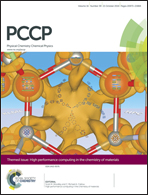Theoretical investigation on structural and electronic properties of organic dye C258 on TiO2(101) surface in dye-sensitized solar cells†
Abstract
The structural and electronic properties of an organic dye C258 before and after being adsorbed onto a TiO2(101) surface by two adsorption modes, monodentate (Mha) and bidentate bridging (BBH), have been investigated in detail. The combination of density functional tight-binding (DFTB), density functional theory (DFT), and time-dependent DFT (TDDFT) approaches have been employed. DFT calculations show that C258 has remarkable charge-transfer characteristics, which favors fast electron injection from the excited dye to the conduction band of TiO2. A detailed analysis of the adsorbate contributions of the dye molecule to band states of TiO2 shows a strong coupling of the adsorbate orbitals with the substrate orbitals. Significant electronic transfer characteristics across the interface reveal a direct electron injection mechanism arising from the electronic excitation of the anchoring group of C258 to the conduction bands of TiO2. The adsorption energy and the electron density distribution demonstrate that the BBH structure is more stable and has a stronger coupling with TiO2 than the Mha pattern, which is able to better promote the electron injection to increase the efficiency of dye-sensitized solar cells (DSSCs).


 Please wait while we load your content...
Please wait while we load your content...